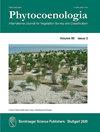Numerical classification of alder carr and riparian alder forests in Slovakia
IF 0.9
4区 生物学
Q4 ECOLOGY
引用次数: 22
Abstract
Syntaxonomy and ecology of the alder carr (alliance Alnion glutinosae) and riparian alder forests (suballiance Alnenion glutinoso-incanae) of Slovakia have not yet been critically revised. Application of numerical approach allowed us to disentangle and resolve syntaxonomical affinities among vegetation units previously reported in Slovakia. The present synthesis was based on analysis of 918 recent and historical phytosociological relevés originating from the Slovak Vegetation Database and available unpublished sources. Three floristically and ecologically interpretable associations of the Euro-Siberian alder carr forests of Alnion glutinosae (Thelypterido palustris-Alnetum glutinosae Klika 1940, Carici elongatae-Alnetum glutinosae Tüxen 1931, Carici acutiformis-Alnetum glutinosae Scamoni 1935) and seven of the European ash-alder riparian forests of Alnenion glutinoso-incanae (Carici remotae-Fraxinetum excelsioris Koch ex Faber 1936, Stellario nemorum-Alnetum glutinoase Lohmeyer 1957, Pruno padiFraxinetum excelsioris Oberdorfer 1953, Matteuccio struthiopteridis-Alnetum glutinosae Magic et Kliment in Kliment et Watzka 2000, Cardamino amarae-Alnetum incanae Šomšák 1961, Piceo abietis-Alnetum glutinosae Mráz 1959, Alnetum incanae Lüdi 1921) have been identified using unsupervised numerical classification. Each association was characterized by list of synonyms, diagnostic, constant and dominant species, overall floristic description, site requirements and chorological aspect. Main environmental gradients responsible for vegetation changes were determined in detrended correspondence analysis and interpreted using the Ellenberg indicator values (EIV) and altitude. Variation in species composition pattern corresponded to the altitudinal gradient and EIV for moisture, nutrients and soil reaction.斯洛伐克桤木和河岸桤木林的数值分类
斯洛伐克桤木(Alnion glutinosae)和河岸桤木林(Alnenion glutinosoincanae亚联盟)的分类学和生态学尚未得到严格修订。数值方法的应用使我们能够解开和解决以前在斯洛伐克报道的植被单位之间的分类学亲和力。目前的综合是基于对来自斯洛伐克植被数据库和现有的未发表来源的918个最近和历史植物社会学相关数据的分析。欧洲-西伯利亚桤木林(Thelypterido palustris-Alnetum glutinosae Klika 1940, Carici elongatae-Alnetum glutinosae txen 1931, Carici acutiformis-Alnetum glutinosae Scamoni 1935)和7个欧洲灰桤木河岸林(Carici remote - fraxinetum excelsioris Koch ex Faber 1936, Stellario nemorum-Alnetum glutinoase Lohmeyer 1957)的植物区系和生态学可解释的关联Pruno padiFraxinetum excelsioris Oberdorfer 1953, Matteuccio struthiopteridis-Alnetum glutinosae Magic et Kliment in Kliment et Watzka 2000, Cardamino amarae-Alnetum incanae Šomšák 1961, Piceo abietis-Alnetum glutinosae Mráz 1959, Alnetum incanae l di 1921)已经用无监督的数字分类方法鉴定。每个群落的特征包括同义种、诊断种、常种和优势种、总体区系描述、地点要求和年代特征。通过非趋势对应分析确定了导致植被变化的主要环境梯度,并利用Ellenberg指标值(EIV)和海拔对其进行了解译。物种组成格局的变化与海拔梯度和水分、养分和土壤反应的EIV相对应。
本文章由计算机程序翻译,如有差异,请以英文原文为准。
求助全文
约1分钟内获得全文
求助全文
来源期刊

Phytocoenologia
生物-植物科学
CiteScore
2.60
自引率
0.00%
发文量
7
审稿时长
>12 weeks
期刊介绍:
Phytocoenologia is an international, peer-reviewed journal of plant community ecology. It is devoted to vegetation survey and classification at any organizational and spatial scale and without restriction to certain methodological approaches. The journal publishes original papers that develop new vegetation typologies as well as applied studies that use such typologies, for example, in vegetation mapping, ecosystem modelling, nature conservation, land use management or monitoring. Particularly encouraged are methodological studies that design and compare tools for vegetation classification and mapping, such as algorithms, databases and nomenclatural principles. Papers dealing with conceptual and theoretical bases of vegetation survey and classification are also welcome. While large-scale studies are preferred, regional studies will be considered when filling important knowledge gaps or presenting new methods.
 求助内容:
求助内容: 应助结果提醒方式:
应助结果提醒方式:


